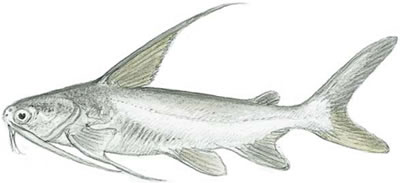 |
| Gafftopsail Catfish (Bagre marinus) |
This sea catfish is a common catch by both commercial fishermen and recreational anglers in the Gulf Coast, especially between April and August. Its dark, tender, lean meat is popular as table fare and has a moderate flavor. Identification. The gafftopsail catfish has a steel-blue dorsal fin, silvery ventral fins, and a robust body, with a depressed broad head, featuring a few flattened barbels. The dorsal and the pectoral fins have greatly elongated spines.
Size/Age
Mature gafftopsails grow to 36 inches and 10 pounds. Average small fish weigh less than a pound to 1.5 pounds and are 17 inches long. The maximum age is unknown.
Life history/Behavior
Gafftopsail catfish move in large schools and migrate from bays and estuaries to shallow open waters of the Gulf of Mexico in the winter. This movement and migration in gulf coastal and estuarine waters are related to spawning activity and environmental conditions. Spawning takes place in the waters of inshore mud flats between April and July and has some unusual
characteristics.
Gafftopsails reach sexual maturity at the age of 2 and are between 10 and 11 inches in length at the time. They have low fecundity, producing just 20 to 64 eggs per female; their eggs are believed to be the largest of all eggs produced by bony fish. Males carry the eggs and young in their mouths for 11 to 13 weeks until they are about 3 inches long; as many as 55 young have been reportedly carried in this manner at a time
Food and feeding habits
Crabs, shrimp, and various small fish make up their diet, but like all catfish, gafftopsails have broad dietary interests.
Other Names
bandera, sailboat cat, gafftopsail sea catfish, gafftop cat, tourist trout; Portuguese: bagre-fita; Spanish: bagre cacumo.
Distribution
These fish range along the western Atlantic coast from Cape Cod to Panama and throughout the Gulf of Mexico, being abundant along Louisiana and Texas. They are absent from most of the West Indies and the Caribbean Islands but are present in western Cuba and extend to Venezuela and possibly as far south as Brazil.
 |
| Catching Gafftopsail Catfish |
Habitat
Gafftopsails prefer deeper channels, particularly brackish water in bays and estuaries with sandy bottoms of high organic content. They prefer water temperatures between 68° and 95°F.



